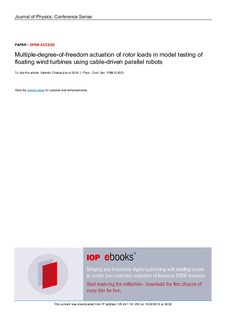| dc.contributor.author | Chabaud, Valentin Bruno | |
| dc.contributor.author | Eliassen, Lene | |
| dc.contributor.author | Thys, Maxime | |
| dc.contributor.author | Sauder, Thomas Michel | |
| dc.date.accessioned | 2019-02-19T08:04:27Z | |
| dc.date.available | 2019-02-19T08:04:27Z | |
| dc.date.created | 2018-11-26T15:44:21Z | |
| dc.date.issued | 2018 | |
| dc.identifier.issn | 1742-6588 | |
| dc.identifier.uri | http://hdl.handle.net/11250/2586085 | |
| dc.description.abstract | Model testing of offshore structures in ocean basins has been accepted as a necessary step for the validation and calibration of numerical models, as well as for final design checks in extreme environments. While offshore wind power makes no exception, model testing has not shown its full potential due to inherent modeling challenges. Generating highly-controlled wind fields in ocean basins and alleviating aerodynamic modeling errors due to Reynolds number mismatch in Froude-based scaling are prominent examples. To circumvent these issues, the concept of Real-Time Hybrid Model (ReaTHM) testing has been suggested by SINTEF Ocean and NTNU, Norway. Here the wind loads are no longer physically modeled but computed from online-measured motions and a numerical wind field. They are then actuated in real time on the scale model by means of actuators, while subjected to -physical-wave and current loads.
This paper aims at presenting design considerations regarding the choice of the actuator(s) and its/their interface with the scale model. The pros and cons of the chosen solution, namely cable-driven parallel robots using industrial servo drives, are presented. The focus is then directed toward the mapping between wind loads to be actuated and tension commands on each cable, called tension allocation. Two layouts corresponding to two ReaTHM testing campaigns performed in SINTEF Ocean's ocean basin are then compared on various aspects, with emphasis on tension allocation.
In addition to proving the feasibility of the chosen technical solution, results show a tradeoff between flexibility (with respect among others to wind direction) and usability on other structures versus minimization of cable tensions. The latter aspect is treated in detail, using theory first adapted from literature on cable-driven parallel robots, then illustrated through relevant examples for the current application. | nb_NO |
| dc.language.iso | eng | nb_NO |
| dc.publisher | IOP Publishing | nb_NO |
| dc.rights | Navngivelse 4.0 Internasjonal | * |
| dc.rights.uri | http://creativecommons.org/licenses/by/4.0/deed.no | * |
| dc.title | Multiple-degree-of-freedom actuation of rotor loads in model testing of floating wind turbines using cable-driven parallel robots | nb_NO |
| dc.title.alternative | Multiple-degree-of-freedom actuation of rotor loads in model testing of floating wind turbines using cable-driven parallel robots | nb_NO |
| dc.type | Journal article | nb_NO |
| dc.type | Peer reviewed | nb_NO |
| dc.description.version | publishedVersion | nb_NO |
| dc.source.volume | 1104 | nb_NO |
| dc.source.journal | Journal of Physics, Conference Series | nb_NO |
| dc.identifier.doi | 10.1088/1742-6596/1104/1/012021 | |
| dc.identifier.cristin | 1635305 | |
| dc.description.localcode | Content from this work may be used under the terms of the Creative Commons Attribution 3.0 licence. Any further distribution of this work must maintain attribution to the author(s) and the title of the work, journal citation and DOI. Published under licence by IOP Publishing Ltd. | nb_NO |
| cristin.unitcode | 194,64,20,0 | |
| cristin.unitname | Institutt for marin teknikk | |
| cristin.ispublished | true | |
| cristin.fulltext | postprint | |
| cristin.qualitycode | 1 | |

